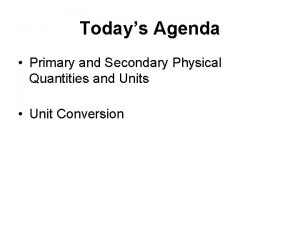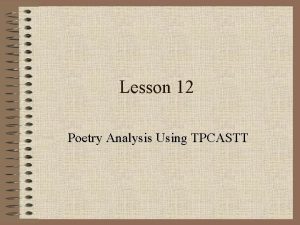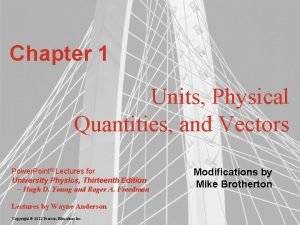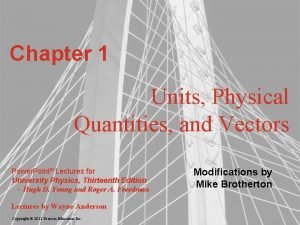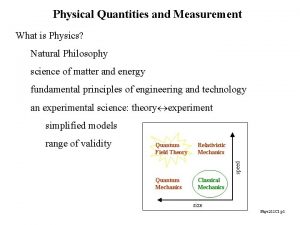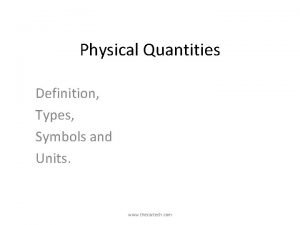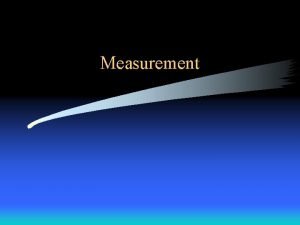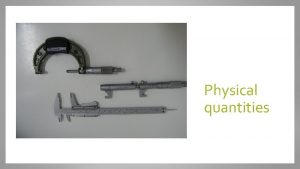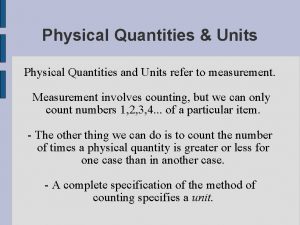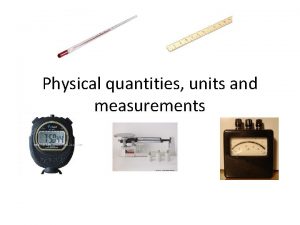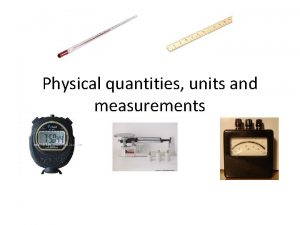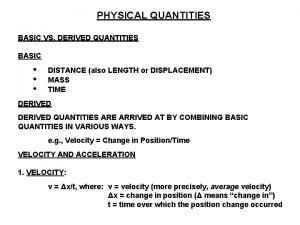Todays Agenda Primary and Secondary Physical Quantities and









- Slides: 9

Today’s Agenda • Primary and Secondary Physical Quantities and Units • Unit Conversion

Standard We Will Use • We will follow the International System of Units – also known as the SI standard – It includes: Distance measured in meters (m) Mass measured in kilograms (kg) Time measured in seconds (s) Charge measured in Coulombs (C) Temperature measured in degrees Kelvin (o K or K) • That means we’ll need to convert other measures to our standard

Fundamental or Primary Quantities • 7 SI base units: those from which all others are derived – – – – meter kilogram second ampere kelvin candela mole (m) (kg) (s) (A) (K) (cd) (mol) length weight time current temperature luminosity molecular quantity Quick in-class exercise: – Identify physical examples, and electrical examples

Derived or Secondary Quantities • “SI derived unit”: derived from base units • Unlimited number of derived units! • Some examples: – – – meter / second squared newton pascal joule volt watt ohm farad henry hertz (N) (Pa) (J) (V) (W) (Ω) (F) (Hz) m/s 2 kg·m / s 2 N / m 2 N·m kg⋅m 2⋅s− 3⋅A− 1 J / s V / A C / V V⋅s / A 1 / s velocity acceleration force pressure energy voltage power resistance capacitance inductance frequency

Commonly used prefixes T G M k tera giga mega kilo 1012 109 106 103 d c d μ n p deci centi milli micro nano pico 10 -1 10 -2 10 -3 10 -6 10 -9 10 -12

What Units Should We Use? • Example distance units: • Example time units:

What Happens If We Mix Units? • Consider the Mars Climate Orbiter that was launched in 1998 (see handout). • It turns out that someone at NASA forgot to convert English units (pounds) to metric units (Newtons) when calculating the necessary rocket thrust to put the craft in orbit around Mars • Guess what happened?

Class Activity #1 a. ) A tractor-trailer truck is traveling at 60 miles per hour eastbound on Interstate 195 towards the North Dartmouth exit. Determine the speed of the truck i. ) in feet per second ii. ) in meters per second iii. ) in kilometers per hour. b. ) What is the maximum legal speed in centimeters per hour in a 55 miles per hour posted speed zone?

Homework for next class • In the textbook, – Read Chapter I (Introduction) – Read Chapter 1
 Secondary quantity
Secondary quantity Angular quantities and linear quantities cannot be related.
Angular quantities and linear quantities cannot be related. Todays agenda
Todays agenda Physical quantities units and measurement
Physical quantities units and measurement Units, physical quantities and vectors
Units, physical quantities and vectors Physical quantities and vectors
Physical quantities and vectors What is physics
What is physics Agenda sistemica y agenda institucional
Agenda sistemica y agenda institucional What is physical quantity
What is physical quantity All physical quantities are measurable or not
All physical quantities are measurable or not
